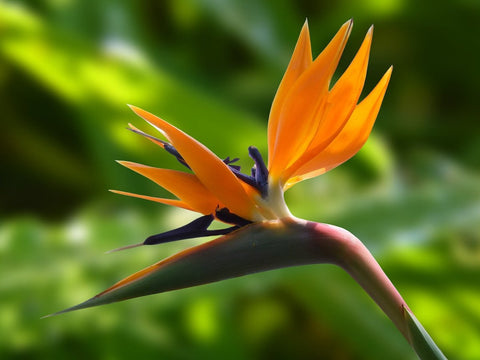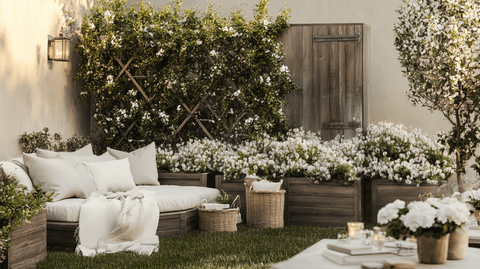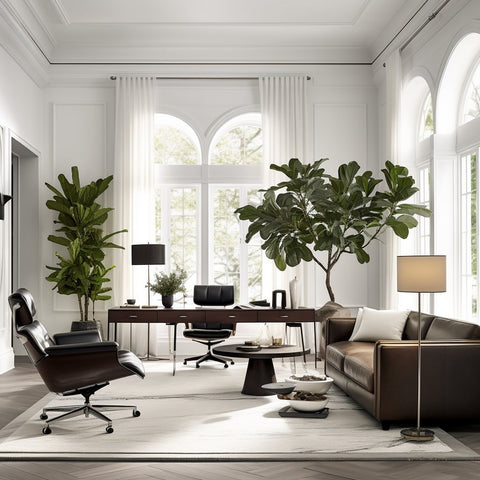I. Introduction

The Bird of Paradise plant, known scientifically as Strelitzia Reginae, is a tropical beauty that can transform any space into a lush paradise. With its large, glossy leaves and striking flowers that resemble a bird in flight, it's no wonder this plant is a favorite among gardeners and interior designers alike.
However, like any living thing, the Bird of Paradise plant requires proper care to thrive. Understanding its needs and providing the right conditions can ensure that your plant remains healthy and vibrant, bringing a touch of the tropics to your home or garden.
Whether you're a seasoned gardener or a beginner, this comprehensive guide will provide you with all the information you need to successfully grow and care for your Bird of Paradise plant. Let's dive in!
II. Origin and Description of Bird of Paradise Plant
A. Historical background
The Bird of Paradise plant is native to South Africa, where it grows wild in coastal areas. It was first introduced to Europe in the late 18th century and quickly became popular due to its exotic appearance and vibrant colors. Today, it's grown worldwide as an ornamental plant, both indoors and outdoors.
B. Physical characteristics
The Bird of Paradise plant is known for its large, banana-like leaves and stunning flowers. The flowers, which can bloom all year round in the right conditions, are made up of three bright orange sepals and three blue petals. They're held aloft on long stems, giving the appearance of a bird in flight - hence the plant's common name.
When grown outdoors in its native habitat, the Bird of Paradise plant can reach up to 6 feet in height. However, when grown indoors, it typically reaches a more manageable 3-4 feet.
III. Importance of Bird of Paradise Plant
A. Ecological significance
In its native South Africa, the Bird of Paradise plant plays a crucial role in the local ecosystem. Its nectar-rich flowers attract birds, particularly sunbirds, which help to pollinate the plant. In turn, this helps to maintain biodiversity in the area.
B. Aesthetic value in landscaping and interior design
With its tropical appeal and striking flowers, the Bird of Paradise plant is a popular choice in landscaping and interior design. It's often used as a focal point in gardens, patios, and indoor spaces. Its large, glossy leaves also make it an excellent choice for creating a lush, tropical feel.
Furthermore, the Bird of Paradise plant is a popular choice for house plants and patio plants due to its ability to thrive in containers. It's also a favorite among indoor plant enthusiasts for its air-purifying qualities.
IV. Ideal Growing Conditions for Bird of Paradise Plant
A. Preferred climate
The Bird of Paradise plant is a tropical species, which means it prefers warm, humid climates. It's hardy in USDA zones 10-12, where it can be grown outdoors year-round. However, it can also be grown indoors in cooler climates, provided it's given enough light and humidity.
B. Ideal soil type
This plant prefers a well-draining soil mix to prevent waterlogging and root rot. A mix of peat, perlite, and compost is often recommended. The soil should be slightly acidic to neutral, with a pH between 6.0 and 7.5.
C. Light requirements
The Bird of Paradise plant needs plenty of bright, indirect light to thrive. It can tolerate some direct sunlight, but too much can scorch the leaves. If you're growing the plant indoors, a south or west-facing window is ideal.
V. Planting the Bird of Paradise
A. Choosing the right location
When choosing a location for your Bird of Paradise plant, consider its light and space requirements. The plant needs plenty of bright, indirect light, so a spot near a south or west-facing window is ideal if you're growing it indoors. If you're planting it outdoors, choose a spot that gets plenty of sunlight but is protected from the hottest midday rays.
B. Preparing the soil
Before planting, prepare the soil by mixing in plenty of organic matter to improve drainage and fertility. If the soil is heavy clay, you may also need to add some sand or perlite to improve its structure. The soil should be slightly acidic to neutral, with a pH between 6.0 and 7.5.
C. Planting process
To plant your Bird of Paradise, dig a hole twice as wide and just as deep as the root ball. Place the plant in the hole, making sure the top of the root ball is level with the soil surface. Backfill with the prepared soil, firming it gently around the base of the plant. Water thoroughly after planting.
VI. Watering Requirements
A. Frequency of watering
The Bird of Paradise plant likes to stay evenly moist, but not waterlogged. In general, you should water when the top inch of soil feels dry to the touch. This usually means watering once a week in the summer and once every two weeks in the winter. However, this can vary depending on the plant's size, the pot size, and the environment.
B. Amount of water needed
When watering your Bird of Paradise plant, aim to thoroughly saturate the soil. However, make sure the pot has good drainage to prevent water from sitting in the bottom, which can lead to root rot. A good rule of thumb is to water until you see water coming out of the drainage holes at the bottom of the pot.
C. Signs of overwatering or underwatering
Overwatering and underwatering can both cause problems for your Bird of Paradise plant. Signs of overwatering include yellowing leaves, wilting, and root rot. On the other hand, underwatering can cause the leaves to become dry and crispy. If you notice any of these symptoms, adjust your watering schedule accordingly.
VII. Fertilizing the Bird of Paradise Plant
A. Type of fertilizer needed
The Bird of Paradise plant benefits from regular feeding during the growing season. Use a balanced, water-soluble fertilizer with equal amounts of nitrogen, phosphorus, and potassium. You can also add a slow-release granular fertilizer to the soil at planting time to provide a steady supply of nutrients.
B. Frequency of fertilization
Fertilize your Bird of Paradise plant every two weeks during the growing season (spring and summer) and once a month during the dormant season (fall and winter). Always water the plant thoroughly after fertilizing to prevent the fertilizer from burning the roots.
C. How to apply the fertilizer
To apply the fertilizer, mix it with water according to the package instructions. Then, pour the solution onto the soil around the base of the plant. Avoid getting fertilizer on the leaves, as this can cause them to burn.
VIII. Pruning and Maintenance
A. When to prune
The Bird of Paradise plant doesn't require much pruning, but you can trim off any dead or damaged leaves as needed to keep the plant looking its best. The best time to prune is in the spring, just before the new growth starts.
B. How to prune properly
To prune your Bird of Paradise plant, use a sharp, clean pair of pruning shears. Cut off the leaf at the base of the stem, being careful not to damage the main stalk. If you're removing a flower, cut it off at the base of the flower stalk.
C. General maintenance tips
In addition to regular watering and feeding, the Bird of Paradise plant benefits from regular misting to increase humidity. You should also wipe the leaves with a damp cloth every now and then to remove dust and keep them looking shiny. If you're growing the plant indoors, rotate it every few weeks to ensure it gets even light exposure.
IX. Dealing with Pests and Diseases
A. Common pests and diseases
The Bird of Paradise plant is generally quite resistant to pests and diseases, but it can sometimes be affected by common houseplant pests like spider mites, mealybugs, and aphids. Diseases like root rot can also occur if the plant is overwatered or if the soil doesn't drain well.
B. Prevention methods
The best way to prevent pests and diseases is to provide the right growing conditions for your Bird of Paradise plant. This includes using well-draining soil, watering properly, and providing plenty of light. Regularly inspecting your plant for signs of pests and removing any affected leaves can also help to keep it healthy.
C. Treatment options
If your Bird of Paradise plant does get infested with pests, you can usually get rid of them by wiping the leaves with a cloth soaked in a solution of water and mild dish soap. For more severe infestations, you may need to use a horticultural oil or insecticidal soap. If your plant gets root rot, you'll need to repot it in fresh, well-draining soil and cut off any affected roots.
X. Propagating the Bird of Paradise Plant
A. When and how to propagate
The Bird of Paradise plant can be propagated by division. The best time to do this is in the spring, when the plant is starting its active growth period. To propagate, simply remove the plant from its pot and gently separate the root ball into two or more sections. Each section should have at least one stem and plenty of roots. Then, repot each section in its own pot with fresh soil.
B. Caring for new plants
After propagation, care for your new Bird of Paradise plants as you would a mature plant. Keep the soil evenly moist, provide plenty of light, and feed regularly during the growing season. With proper care, your new plants should start to grow and bloom in their own time.
XI. Winter Care for Bird of Paradise Plant
A. Preparing the plant for winter
If you live in a climate where temperatures drop below freezing in the winter, you'll need to bring your Bird of Paradise plant indoors before the first frost. Before bringing it inside, check the plant thoroughly for pests and treat if necessary. Also, reduce watering and stop feeding the plant to help it adjust to the lower light levels indoors.
B. Indoor care tips during winter
During the winter, keep your Bird of Paradise plant in a bright, warm location. Continue to water sparingly, allowing the top inch of soil to dry out between waterings. You can also increase humidity by placing the pot on a tray filled with pebbles and water, or by using a humidifier.
XII. Troubleshooting Common Problems
A. Yellowing leaves
Yellowing leaves can be a sign of overwatering or poor drainage. If you notice this, check the soil to see if it's waterlogged. If it is, you may need to repot the plant in a pot with better drainage or adjust your watering schedule.
B. Lack of flowering
If your Bird of Paradise plant isn't flowering, it could be due to insufficient light, lack of nutrients, or it may simply be too young. These plants typically start to flower when they're about 5 years old. If your plant is mature and still not flowering, try moving it to a brighter location and feeding it with a high-phosphorus fertilizer to encourage blooming.
C. Root rot
Root rot is a common problem in plants that are overwatered or have poor drainage. If you notice a foul smell or black, mushy roots, your plant may have root rot. To treat this, remove the plant from its pot, cut off any affected roots, and repot in fresh, well-draining soil.
XIII. Benefits of Growing Bird of Paradise Plant
A. Environmental benefits
Like all plants, the Bird of Paradise plant helps to purify the air by absorbing carbon dioxide and releasing oxygen. It also helps to increase humidity, which can be beneficial in dry indoor environments.
B. Health benefits
Having plants in your home or office can have numerous health benefits. They can help to reduce stress, improve mood, and even boost productivity. Plus, the Bird of Paradise plant's vibrant flowers can bring a touch of joy and beauty to any space.
C. Aesthetic benefits
With its tropical appeal and stunning flowers, the Bird of Paradise plant is a great way to add a touch of the exotic to your home or garden. Whether you're creating a tropical-themed garden or just want a striking indoor plant, the Bird of Paradise is a fantastic choice.
XIV. Conclusion
As you can see, the Bird of Paradise plant is a stunning addition to any home or garden. With its vibrant flowers and lush foliage, it's sure to turn heads wherever it's planted. Plus, with the right care, it's a relatively easy plant to grow, making it a great choice for both novice and experienced gardeners.
So why not bring a touch of the tropics to your home with a Bird of Paradise plant? With this comprehensive guide, you'll have all the knowledge you need to successfully grow and care for this exotic beauty. Happy gardening!
For more information on other tropical plants, check out our guides on tropical plants and tropical patio plants.
XV. References
For further reading on the Bird of Paradise plant and its care, we recommend the following resources:
- Missouri Botanical Garden: Strelitzia reginae
- Royal Horticultural Society: Strelitzia reginae
- Gardening Know How: Bird of Paradise
FAQs
How often should I water my Bird of Paradise plant?
In general, you should water your Bird of Paradise plant when the top inch of soil feels dry to the touch. This usually means watering once a week in the summer and once every two weeks in the winter. However, this can vary depending on the plant's size, the pot size, and the environment.
Why is my Bird of Paradise plant not flowering?
If your Bird of Paradise plant isn't flowering, it could be due to insufficient light, lack of nutrients, or it may simply be too young. These plants typically start to flower when they're about 5 years old. If your plant is mature and still not flowering, try moving it to a brighter location and feeding it with a high-phosphorus fertilizer to encourage blooming.
Can I grow a Bird of Paradise plant indoors?
Yes, the Bird of Paradise plant can be grown indoors, provided it's given enough light and humidity. It's a popular choice for house plants due to its tropical appeal and air-purifying qualities.






























Comments (0)
There are no comments for this article. Be the first one to leave a message!